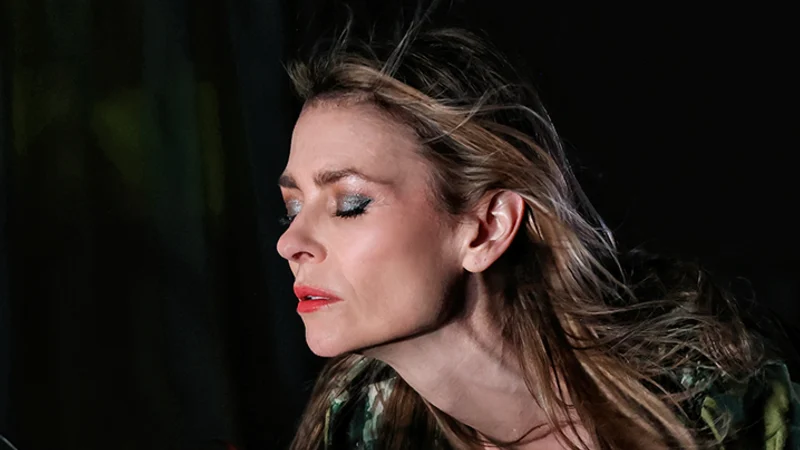
Finishing off with the epic classics Master of Puppets, One and Enter Sandman was nothing short of spectacular.
AC/DC lands at Accor Stadium on Friday. Over to you, Angus and Co. Don’t let the side down.
THEATRE
Gravity
The Loading Dock Theatre, Qtopia
December 14
Reviewed by CASSIE TONGUE
★★★
The theatre spaces at Qtopia, the Darlinghurst centre for queer history and culture, offer opportunities for independent artists to explore queer stories, develop their art, and share their experiences. It’s a natural home for Gravity, by debut playwright Bradford Elmore (host of the By the Bi podcast).
In a whirlwind 70 minutes, Christopher (Wesley Senna Cortes) and Heather (Annabelle Kablean) meet-cute in a bookshop. There’s an instant spark, and in a quick montage they marry and settle into life together. But there’s more to their stories than the happily ever after. When travelling for work, Christopher meets David (Drew Wilson), and there’s something unexpected: another spark.
Heather (Annabelle Kablean) and Christopher (Wesley Senna Cortes) in Gravity. Credit: Phil Erbacher
What does it mean to love more than one person? What does it mean to love people across genders? And how do you explain it all to someone you married a decade ago? Gravity tackles these questions of queerness and polyamory with big feelings and gentle humour.
Director Anthony Skuse, who handles traded intimacies and characters on the brink of change with thoughtfulness and care, keeps the focus square on Christopher, David, and Heather, grounding those big ideas in human hearts and faces. Skuse has also set the production design: it’s a bare stage with a raised and tilted centre that becomes the main playing space, echoing Christopher’s journey – and then Heather and David’s, too – through unknown and unsteady ground.
Gravity is at its best when it brings its honesty to the forefront. It doesn’t skip the difficult discussions, decisions, and occasional mistakes made when discovering something new about yourself and how you love, and the frankest scenes are its strongest.
But there are problems. Like many debut plays, the blend between everyday and heightened dramatic dialogue is off; more lofty lines and metaphors land heavy on the ear. The focus heavily favours one couple’s intimacy and attraction, while the other—and the character of Heather, in turn—is treated as a given and given too little attention in the script (though Kablean is excellent when she is given more to do in the latter stages of the play).
It’s understandable. Christopher and Heather’s relationship, often seen as the societal default, might not have felt as urgent to explore in a play about breaking away from those social expectations in relationships and sexuality. But when we know her less, and he spends more of the play’s runtime away from Heather and growing closer to David, it makes it much harder to feel the full weight and complexity of Christopher’s experience.
It’s also clear, however, that the play’s intentions are to honour its characters as much as it can within 70 minutes and within the framework of the play. There’s real compassion for all three, a few genuinely funny exchanges, and a solid execution of traditional narrative structure, building neatly through complication to a resolution that feels sufficiently earned. Plus, it’s refreshing to see relationships that look like these onstage – we are all better off when more of us are able to share our stories on stage.
THEATRE
WHO’S AFRAID OF VIRGINIA WOOLF?
Roslyn Packer Theatre, November 11
Until December 14
Reviewed by JOHN SHAND
★★★★½
“I do not bray!” brays Martha, responding to George’s gibe that she does. What other play than Edward Albee’s 1962 masterpiece is so funny while being so savage? Precious few are blessed with a character as venomous as Martha who – miraculously – makes us like her. But then this alchemy cannot occur without an actor who can wither with one look and split our sides with the next.
Kat Stewart’s certainly that. This is a performance that will throb in the memory bank long after age has pilfered most of them. Stewart’s light-switch mood changes are scary enough; her Martha’s rage is cyclonic, her intellect formidable, her capacity for alcohol bottomless and the terror on her face near the end heartbreaking.
Kat Stewart’s performance will long live in the memory. Credit: Prudence Upton
She somehow makes you feel Martha’s backstory: the girl who grew up motherless, her father too preoccupied with establishing a New England college to show interest. So Martha craved attention as much as she craved love. Then she met George, and thought him the right horse to ride in academia’s upwardly mobile stakes.
George might have proved a flop in terms of ambition (which she’ll never let him forget), but she loved him because he understood her, and was willing to play the games she devised – a joy she’d never had as a child.
To pull off such a multidimensional performance, Stewart needs the right George, and, just as Elizabeth Taylor and Richard Burton were married when they played Martha and George in Mike Nichols’ timeless film, so Stewart is married to her George, David Whiteley. If Whiteley’s performance doesn’t quite scale Stewart’s heights, he’s on the same mountain face. His George is witty, mostly subdued, sometimes wet and always exhausted by trying to keep up with Martha. Whitely has him stretched thin like fuse wire, so there’s an electricity in who will snap first, however well you know the play.
Sarah Goodes’ production has been polished across three lives, beginning as a Red Stitch production in that company’s tiny Melbourne home, moving to the grander Comedy Theatre and now becoming a Sydney Theatre Company co-presentation.
Harvey Zielinski plays Nick, the hot-shot new faculty member intent on climbing the college ladder, bed by bed. Emily Goddard plays Honey, his bewildered wife, uprooted from the Midwest, and trapped in a loveless marriage. Both mostly shine as their characters totter into George and Martha’s nihilistic void, where secrets are wheeled out as weapons of war.
Goodes’ seamless directing is replete with glistening touches in the 3D pictures she paints, expertly supported by Harriet Oxley’s set, Matt Scott’s lighting and Grace Ferguson and Ethan Hunter’s sparse but telling music.
The intensity flagged a smidgen in act three, just when it should be as taut as drawn bow. At three-and-a-half hours, the play asks big questions of the actors: ones they otherwise meet full-frontally, and none more than Stewart.
THEATRE
So Young
The Old Fitz, until November 22
Reviewed by KATE PRENDERGAST
★★★★½
The abstract of Scottish playwright Douglas Maxwell’s award-winning So Young is enough to make anyone rub their hands in anticipatory glee. Get this: a widower, his beloved wife of many years just three months in the earth, has fallen for a super-fit barmaid more than 20 years his junior.
How scandalous! How derisively rudimentary of male behaviour. I mean, really – what an egregious, avoidant and dick-driven way for that middle-aged fool Milo to handle his grief. His two good friends Liane (Ainslie McGlynn) and Davie (Jeremy Waters), a couple who knew the aforementioned dead wife since their teacher training years, undergo the predictable reactions when introduced to the cheerily unabashed “so young” Greta over dinner at Milo’s.
Milo’s new fiancee Greta (Aisha Aidara) and long-term friend Davie (Jeremy Waters) do their best to navigate a new and unfamiliar terrain in So Young.Credit: Richard Farland
Dowdy schoolmistress Liane does not let decorum stay her sortie of scathing inquisitions and “pronouncements”. She positions herself firmly as merciless truth teller, the only one remaining to defend the honour of a dead woman who was also her dear friend.
“It’s her or me!” she delivers in her ultimatum to Milo.
Davie – a simple man, whom we are introduced to in the first scene by a roar of self-satisfied early ejaculation – actually seems a bit smitten by the charming young woman with the cute and ready smile. She listens to his stories and appreciates his record collections. But he’s hardly one to stand up to his sharp-tongued wife.
Loading
Of course when it’s mounted by Outhouse Theatre, you know that what is kneejerk outrageous or ostensibly taboo is in for a sound dramatic wringing. To borrow from the dialogue of Greta (Aisha Aidara), these guys “don’t flinch”. The company, founded by Waters, has been consistently impressive that way – bringing first-rate modern plays (largely from the US and UK) to rattle our certainties: first with a riotous comedy of manners, then a finely tuned choreography of radical compassion, as human relations run the gamut of clashing preconceptions, are broken open in their frailties, and – with great pain and tenderness – made gingerly anew.
Actor and writer Sam O’Sullivan matches form with his directorial debut. What do we risk by being absolutely uncompromising in our battles? What are we willing to sacrifice for our convictions, and what does it take to examine them in a real and immediate context? And, at the centre of this particular play, what right do even those closest to us have to tell us who and how we love? Lord knows it’s never been frictionless for a friendship group to absorb a new romantic partner, no matter the particulars.
It’s an excellent ensemble that bubbles up this cauldron of questions, with passing Scottish accents too. Waters, wide-eyed and sprawling in his movements, plays a man a little lost in life, gaffe-prone but sweet. McGlynn does important work in overcoming her character’s cliche of a morally righteous harridan.
Loading
Henry Nixon, with his boyish looks and sincere presentation, somehow doesn’t figure Milo as seedy or delusional. Aidara definitely helps in this: her Greta radiates natural strength, animated intelligence and dauntless self-composure.
When the characters peeled off in opposite partner pairs, a tawdry dread portends. Subtle blocking and body language suggests that we may be about to witness real “bad behaviour” on display. That the plot didn’t collapse to this obvious crisis point was a huge, commendable relief.
Two startlingly poignant symbols are at work in Maxwell’s tale. One is a wine-soaked anecdote of a lion’s paralysing roar. The other is an unopened bottle of Japanese whisky. It may be served a little too neat at the end, but So Young is strong, sterling stuff, pitting the “shapeable present” against the “irreconcilable past”.
MUSIC
Cocteau’s Circle
Australian Chamber Orchestra
City Recital Hall, November 8
Reviewed by PETER McCALLUM
★★★½
In 1918, as a shell-shocked France adjusted itself to the prospect of peace, writer, filmmaker and general avant-garde polymath Jean Cocteau produced a small collection of opinionated aphorisms, Le Coq et l’Arlequin, which became, for a time, the unofficial manifesto of the six composers, George Auric, Louis Durey, Arthur Honegger, Darius Milhaud, Germaine Tailleferre and Francis Poulenc, then known as Les Nouveaux Jeunes, but subsequently christened simply as Les Six.
French music, Cocteau argued, should resist the seductive influence of Debussy, Stravinsky and Wagner in favour of the simplicity discovered by Satie. Informality, lightheartedness, irreverence and the spirit of the music hall should always be preferred to the kind of music one listens to with “one’s head in one’s hands”.
In fact, any sense of collective aesthetic among these composers quickly dissolved but the spirit of that moment endured.
Le Gateau Chocolat supervised proceedings at City Recital Hall.Credit: Edwina Pickles
The Australian Chamber Orchestra under Richard Tognetti with director Yaron Lifschitz, cross-dressing singer and maitre d’ Le Gateau Chocolat and true-voiced soprano and talented chanteuse Chloe Lankshear joined forces to conjure that spirit.
Excerpts of pieces by some of Les Six and their contemporaries were woven together with commentary by Le Gateau Chocolat and five subtly allusive interludes by Elena Kats-Chernin.
Bearded, 198 centimetres tall, and dressed in different hues of outrageousness on each appearance, Le Gateau Chocolat linked the anarchic irrationality of the time with modern gender bending and drag.
He mixed deep bass and falsetto in Bess’s song I Loves You, Porgy from Gershwin’s Porgy and Bess, though his difficulty in weaving melodic lines with nuance made his earlier slow rendition of Gershwin’s Oh, Lady Be Good! less successful.
Lankshear sang Bien Chapeautee from Swiss composer Henri Christine’s operetta Phi-Phi with a pure, richly coloured voice of vivacious flexibility. Her reading of Pie Jesu by the tragically short-lived Lili Boulanger, one of the genuine emerging geniuses of the era, was dark and striking and a musical highlight of the program.
Loading
Lankshear closed the evening with a touchingly simple rendition of L’Hymne a l’amour by Edith Piaf, who died the day before Cocteau, her close friend.
A highlight of the instrumental numbers was the first movement of Jean Francaix’s Concertino for Piano and Orchestra, dispatched with light agility by pianist Stefan Cassomenos. With visiting brass and percussion, Tognetti and the ACO captured well the way composers of this period created disorientation and distancing through unusual blends and unconventional balance.
They began with an Ouverture by Auric, contributed angular excerpts by Stravinsky, and ended with the polytonal energy and exuberance of Milhaud’s Le Boeuf sur le toit (a ballet by Milhaud and Cocteau, which gave its name to their favourite nightclub).
The first movement of Tailleferre’s String Quartet wafted caressingly, although the arrangements of movements from Ravel’s and Debussy’s Quartets were less precise in pitch. Restricting the music to excerpts in cabaret style, had some frustrations but whetted the appetite to hear complete performances of the era’s many neglected gems.
MUSIC
Musica Viva, Piotr Anderszewski
City Recital Hall, November 10
Reviewed by PETER McCALLUM
★★★★
Brahms’ late piano pieces often give the impression of music written to be played alone, leaving the listener as a furtive eavesdropper at a half-open door. The textures are predominantly quiet, yet subtly distinctive, allowing the player to tease out ideas in an unhurried way, as though getting to the heart of the matter.
Piotr Anderszewski ranged freely across the four sets, Opus 116, 117, 118 and 119, moving to each new piece without a break as though a mood or a phrase in the previous one had brought next to mind. His selections favoured reflective numbers and he sustained a mood of hushed inner contemplation through singular vision, musical insight and remarkable control over varying shades of quietness.
In Opus 119, No. 1 in B minor he mapped the descending patterns as though trying an idea at the piano, unaware of the harmonies into which it might fall, until new musical thoughts gradually came to the surface.
Piotr Anderszewski’s selections for the recital favoured reflective numbers.Credit: Getty Images
In the third piece from the same set, the melody emerged simply from the inner parts like a shape perceived through bright foliage. The short passionate motive of the Intermezzo, Opus 118, No. 1, emerged with fleeting intensity amid deftly controlled turbulence and the theme of the Opus 118, No. 2 had lingering tenderness without over-sugared sentimentality.
In the Intermezzo, Opus 116, No. 2, he created a sound of dreamy lightness at the start, and a rich glowing tone as the idea moved to the left hand with quietly glistening colour in the right.
Anderszewski created delicate sweetness of the middle section of Opus 116, No. 4 and an austere ghostliness in Opus 116, No. 5, which gave ominous significance to the small rests between motives. The Rhapsody, Opus 119, No. 4 was one of the few moments of vigour in his selection and he closed with subtly nuanced rhythms of Opus 117, No. 1 and lonely sadness of the Intermezzo, Opus 118, No. VI.
Anderszewski also performed the second half without break between works, playing Bach’s Prelude in E Major from Book II of the Well-Tempered Clavier with sunny amiability. In the ensuing Fugue he maintained a sense of momentousness through unwavering tempo, emphasising the “stretto” moments where the entries of the theme overlap liking tolling bells.
The G-sharp minor fugue from the same collection moved seamlessly into the A-flat major of Beethoven’s Piano Sonata No. 31, Opus 110. By maintaining the supremacy of shaped melodic lines, Anderszewski gave persuasive logic to the succession of themes in the first movement. In the Arioso sections of the finale, his playing was insistently unyielding so that the fugue sections opened out as though liberated from obsession and pain.
Find out the next TV, streaming series and movies to add to your must-sees. Get The Watchlist delivered every Thursday.





